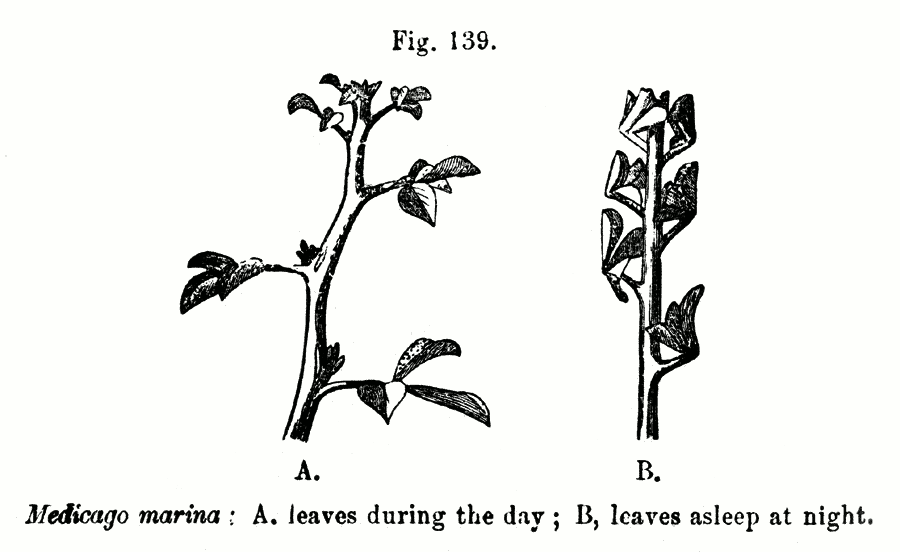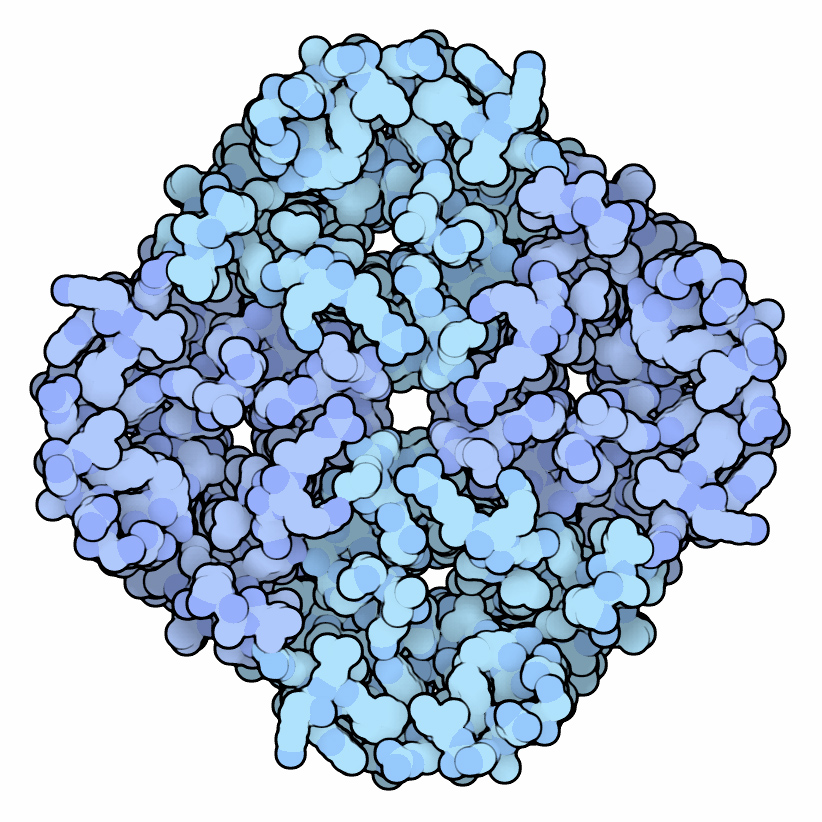|
Pulvini
A pulvinus (pl. ''pulvini'') is a joint-like thickening at the base of a plant leaf or leaflet that facilitates growth-independent movement. Pulvini are common, for example, in members of the bean family Fabaceae (Leguminosae) and the prayer plant family Marantaceae. Pulvini may be present at the base of the leaf stalk or on its other end ( apex), where the leaf is attached, or in a compound leaf at the place where the leaflets are joined to its middle stem. They consist of a core of vascular tissue within a flexible, bulky cylinder of thin-walled parenchyma cells. A pulvinus is also sometimes called a geniculum (meaning a knee-like structure in Latin). Pulvinar movement is caused by changes in turgor pressure leading to a contraction or expansion of the parenchyma tissue. The response is initiated when sucrose is unloaded from the phloem into the apoplast. The increased sugar concentration in the apoplast decreases the water potential and triggers the efflux of potassium ion ... [...More Info...] [...Related Items...] OR: [Wikipedia] [Google] [Baidu] |
Nyctinasty
Nyctinasty is the circadian rhythmic nastic movement of higher plants in response to the onset of darkness, or a plant "sleeping". Nyctinastic movements are associated with diurnal light and temperature changes and controlled by the circadian clock. It has been argued that for plants that display foliar nyctinasty, it is a crucial mechanism for survival; however, most plants do not exhibit any nyctinastic movements. Nyctinasty is found in a range of plant species and across xeric, mesic, and aquatic environments, suggesting that this singular behavior may serve a variety of evolutionary benefits. Examples are the closing of the petals of a flower at dusk and the sleep movements of the leaves of many legumes. Physiology Plants use phytochrome to detect red and far red light. Depending on which kind of light is absorbed, the protein can switch between a Pr state that absorbs red light and a Pfr state that absorbs far red light. Red light converts Pr to Pfr and far red light conver ... [...More Info...] [...Related Items...] OR: [Wikipedia] [Google] [Baidu] |
Mimosa Pudica
''Mimosa pudica'' (from la, pudica "shy, bashful or shrinking"; also called sensitive plant, sleepy plant, action plant, touch-me-not, shameplant) is a creeping annual or perennial flowering plant of the pea/legume family Fabaceae. It is often grown for its curiosity value: the compound leaves fold inward and droop when touched or shaken, defending themselves from harm, and re-open a few minutes later. In the UK it has gained the Royal Horticultural Society's Award of Garden Merit. The species is native to the Caribbean and South and Central America, but is now a pantropical weed, and can now be found in the Southern United States, South Asia, East Asia, Micronesia, Australia, South Africa, and West Africa as well. It is not shade-tolerant and is primarily found on soils with low nutrient concentrations. ''Mimosa pudica'' is well known for its rapid plant movement. Like a number of other plant species, it undergoes changes in leaf orientation termed "sleep" or nyctinastic mov ... [...More Info...] [...Related Items...] OR: [Wikipedia] [Google] [Baidu] |
Fabaceae
The Fabaceae or Leguminosae,International Code of Nomenclature for algae, fungi, and plants. Article 18.5 states: "The following names, of long usage, are treated as validly published: ....Leguminosae (nom. alt.: Fabaceae; type: Faba Mill. Vicia L.; ... When the Papilionaceae are regarded as a family distinct from the remainder of the Leguminosae, the name Papilionaceae is conserved against Leguminosae." English pronunciations are as follows: , and . commonly known as the legume, pea, or bean family, are a large and agriculturally important family of [...More Info...] [...Related Items...] OR: [Wikipedia] [Google] [Baidu] |
Thigmonasty
Thigmonasty or seismonasty is the nastic response of a plant or fungus to touch or vibration. Conspicuous examples of thigmonasty include many species in the leguminous subfamily Mimosoideae, active carnivorous plants such as Dionaea and a wide range of pollination mechanisms. Distinctive aspects Thigmonasty differs from thigmotropism in that nastic motion is independent of the direction of the stimulus. For example, tendrils from a climbing plant are thigmotropic because they twine around any support they touch, responding in whichever direction the stimulus came from. However, the shutting of a venus fly trap is thigmonastic; no matter what the direction of the stimulus, the trap simply shuts (and later possibly opens). The time scales of thigmonastic responses tend to be shorter than those of thigmotropic movements because many examples of thigmonasty depend on pre-accumulated turgor or on bistable mechanisms rather than growth or cell division. Certain dramatic exampl ... [...More Info...] [...Related Items...] OR: [Wikipedia] [Google] [Baidu] |
Aquaporins
Aquaporins, also called water channels, are channel proteins from a larger family of major intrinsic proteins that form pores in the membrane of biological cells, mainly facilitating transport of water between cells. The cell membranes of a variety of different bacteria, fungi, animal and plant cells contain aquaporins through which water can flow more rapidly into and out of the cell than by diffusing through the phospholipid bilayer. Aquaporins have six membrane-spanning alpha helical domains with both carboxylic and amino terminals on the cytoplasmic side. Two hydrophobic loops contain conserved asparagine- proline-alanine ("NPA motif") which form a barrel surrounding a central pore-like region that contains additional protein density. Because aquaporins are usually always open and are prevalent in just about every cell type, this leads to a misconception that water readily passes through the cell membrane down its concentration gradient. Water can pass through the cell me ... [...More Info...] [...Related Items...] OR: [Wikipedia] [Google] [Baidu] |
Anaesthetic
An anesthetic (American English) or anaesthetic (British English; see spelling differences) is a drug used to induce anesthesia — in other words, to result in a temporary loss of sensation or awareness. They may be divided into two broad classes: general anesthetics, which result in a reversible loss of consciousness, and local anesthetics, which cause a reversible loss of sensation for a limited region of the body without necessarily affecting consciousness. A wide variety of drugs are used in modern anesthetic practice. Many are rarely used outside anesthesiology, but others are used commonly in various fields of healthcare. Combinations of anesthetics are sometimes used for their synergistic and additive therapeutic effects. Adverse effects, however, may also be increased. Anesthetics are distinct from analgesics, which block only sensation of painful stimuli. Local anesthetics Local anesthetic agents prevent the transmission of nerve impulses with ... [...More Info...] [...Related Items...] OR: [Wikipedia] [Google] [Baidu] |
Symplast
The symplast of a plant is the inner side of a cell membrane in which water and low-molecular-weight solutes can freely diffuse. Symplast cells have more than one nucleus. ''Symplast'' could also refer to the connection of the inner contents (cytoplasm) of neighbouring cells made by the microscopic channels that traverse the cell walls. These channels, which are called plasmodesmata, allow the direct flow of small molecules such as sugars, amino acids, and ions between cells (from the inner part of one cell to the inner partof the next cell). Larger molecules, including transcription factors and plant viruses, can also be transported through with the help of actin structures. This allows direct cytoplasm-to-cytoplasm flow of water and other nutrients along concentration gradients. In particular, symplastic flow is used in the root systems to bring in nutrients from soil. Nutrient solutes move in this way through three skin layers of the roots: from cells of the ''epidermis'', ... [...More Info...] [...Related Items...] OR: [Wikipedia] [Google] [Baidu] |
ATPase
ATPases (, Adenosine 5'-TriPhosphatase, adenylpyrophosphatase, ATP monophosphatase, triphosphatase, SV40 T-antigen, ATP hydrolase, complex V (mitochondrial electron transport), (Ca2+ + Mg2+)-ATPase, HCO3−-ATPase, adenosine triphosphatase) are a class of enzymes that catalyze the decomposition of ATP into ADP and a free phosphate ion or the inverse reaction. This dephosphorylation reaction releases energy, which the enzyme (in most cases) harnesses to drive other chemical reactions that would not otherwise occur. This process is widely used in all known forms of life. Some such enzymes are integral membrane proteins (anchored within biological membranes), and move solutes across the membrane, typically against their concentration gradient. These are called transmembrane ATPases. Functions Transmembrane ATPases import metabolites necessary for cell metabolism and export toxins, wastes, and solutes that can hinder cellular processes. An important example is the sodium-po ... [...More Info...] [...Related Items...] OR: [Wikipedia] [Google] [Baidu] |
Aquaporin
Aquaporins, also called water channels, are channel proteins from a larger family of major intrinsic proteins that form pores in the membrane of biological cells, mainly facilitating transport of water between cells. The cell membranes of a variety of different bacteria, fungi, animal and plant cells contain aquaporins through which water can flow more rapidly into and out of the cell than by diffusing through the phospholipid bilayer. Aquaporins have six membrane-spanning alpha helical domains with both carboxylic and amino terminals on the cytoplasmic side. Two hydrophobic loops contain conserved asparagine- proline-alanine ("NPA motif") which form a barrel surrounding a central pore-like region that contains additional protein density. Because aquaporins are usually always open and are prevalent in just about every cell type, this leads to a misconception that water readily passes through the cell membrane down its concentration gradient. Water can pass through the cell m ... [...More Info...] [...Related Items...] OR: [Wikipedia] [Google] [Baidu] |
Phytochrome
Phytochromes are a class of photoreceptor in plants, bacteria and fungi used to detect light. They are sensitive to light in the red and far-red region of the visible spectrum and can be classed as either Type I, which are activated by far-red light, or Type II that are activated by red light. Recent advances have suggested that phytochromes also act as temperature sensors, as warmer temperatures enhance their de-activation. All of these factors contribute to the plant's ability to germinate. Phytochromes control many aspects of plant development. They regulate the germination of seeds (photoblasty), the synthesis of chlorophyll, the elongation of seedlings, the size, shape and number and movement of leaves and the timing of flowering in adult plants. Phytochromes are widely expressed across many tissues and developmental stages. Other plant photoreceptors include cryptochromes and phototropins, which respond to blue and ultraviolet-A light and UVR8, which is sensitive to ... [...More Info...] [...Related Items...] OR: [Wikipedia] [Google] [Baidu] |
Circadian Clock
A circadian clock, or circadian oscillator, is a biochemical oscillator that cycles with a stable phase and is synchronized with solar time. Such a clock's ''in vivo'' period is necessarily almost exactly 24 hours (the earth's current solar day). In most living things, internally synchronized circadian clocks make it possible for the organism to anticipate daily environmental changes corresponding with the day–night cycle and adjust its biology and behavior accordingly. The term circadian derives from the Latin ''circa'' (about) ''dies'' (a day), since when taken away from external cues (such as environmental light), they do not run to exactly 24 hours. Clocks in humans in a lab in constant low light, for example, will average about 24.2 hours per day, rather than 24 hours exactly. The normal body clock oscillates with an endogenous period of exactly 24 hours, it entrains, when it receives sufficient daily corrective signals from the environment, primarily daylight and darkne ... [...More Info...] [...Related Items...] OR: [Wikipedia] [Google] [Baidu] |



.jpg)
